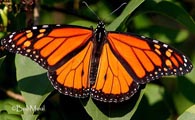Native Plants
Search for native plants by scientific name, common name or family. If you are not sure what you are looking for, try the Combination Search or our Recommended Species lists.
Apocynum androsaemifolium
Apocynum androsaemifolium L.
Spreading Dogbane, Bitterroot, Flytrap Dogbane
Apocynaceae (Dogbane Family)
Synonym(s): Apocynum ambigens, Apocynum androsaemifolium ssp. pumilum, Apocynum androsaemifolium var. glabrum, Apocynum androsaemifolium var. griseum, Apocynum androsaemifolium var. incanum, Apocynum androsaemifolium var. intermedium, Apocynum androsaemifolium var. pumilum, Apocynum androsaemifolium var. tomentellum, Apocynum androsaemifolium var. woodsonii, Apocynum pumilum, Apocynum pumilum var. rhomboideum, Apocynum scopulorum
USDA Symbol: APAN2
USDA Native Status: L48 (N), AK (N), CAN (N)
A 2-3 ft. widely branching, bushy, perennial with opposite, oval leaves and small groups of tiny, pink, bell-shaped flowers near the branch tips. The flowers’ fragrance is reminiscent of lilac. Numerous small pink, nodding, bell-like flowers, fragrant and striped inside with deeper pink. Milky juice exudes from broken stems and leaves.
These plants are relatives of the milkweeds. Indian Hemp (A. cannabinum), a slightly smaller species with erect clusters of greenish-white flowers, is also found in fields and is poisonous. Clasping-leaved Dogbane (A. sibiricum), found widely throughout the Northeast in sandy or gravelly habitats such as stream banks, has stalkless or nearly stalkless leaves.
Once thought to be a larval food for Monarch butterflies, research has shown that while adult female Monarchs will occasionally oviposit on this species, their offspring will not mature on it.
Plant Characteristics
Duration: PerennialHabit: Herb
Root Type: Tap
Leaf Complexity: Simple
Leaf Shape: Ovate
Leaf Venation: Pinnate
Leaf Pubescence: Glabrous
Leaf Margin: Entire
Leaf Apex: Acute
Leaf Base: Rounded
Breeding System: Flowers Bisexual
Fruit Type: Follicle
Size Notes: Up to about 3 feet tall.
Flower: Flowers 5-7 mm long.
Fruit: 15 cm.
Bloom Information
Bloom Color: White , PinkBloom Time: May , Jun , Jul , Aug , Sep
Distribution
USA: AK , AL , AR , AZ , CA , CO , CT , DC , DE , GA , IA , ID , IL , IN , MA , MD , ME , MI , MN , MO , MT , NC , ND , NE , NH , NJ , NM , NV , NY , OH , OK , OR , PA , RI , SD , TN , TX , UT , VA , VT , WA , WI , WV , WYCanada: AB , BC , MB , NB , NL , NS , ON , PE , QC , SK
Native Distribution: Nf. to B.C., s. to GA mts. & AZ
Native Habitat: Forest, Woodland, Forest Edge, Prairie, Meadow, Field
Growing Conditions
Water Use: MediumLight Requirement: Sun , Part Shade , Shade
Soil Moisture: Dry
Drought Tolerance: High
Soil Description: Sandy or gravelly soils.
Conditions Comments: Spreads so rapidly from creeping underground stems that it should not be used in small garden settings.
Benefit
Use Wildlife: BeesUse Other: Women of some tribes rolled dogbane stem fibres on their legs to make fine thread, said to be finer and stronger than the best cotton thread. It was used for sewing and for making twine, nets, fabric and bowstrings.
Warning: The poisonous, acrid sap was said to stimulate hair growth by irritating the follicles, but people with sensitive skin are more likely to develop blisters than hair. (Kershaw)
Conspicuous Flowers: yes
Fragrant Flowers: yes
Attracts: Butterflies
Nectar Source: yes
Poisonous: yes
Value to Beneficial Insects
Supports Conservation Biological ControlThis information was provided by the Pollinator Program at The Xerces Society for Invertebrate Conservation.
Butterflies and Moths of North America (BAMONA)
|
Monarch (Danaus plexippus)  Adult Food Source |
Propagation
Commercially Avail: yesFind Seed or Plants
Find seed sources for this species at the Native Seed Network.
View propagation protocol from Native Plants Network.
National Wetland Indicator Status
| Region: | AGCP | AK | AW | CB | EMP | GP | HI | MW | NCNE | WMVE |
| Status: | UPL | UPL | UPL | FACU | UPL | UPL | UPL | FACU |
From the National Organizations Directory
According to the species list provided by Affiliate Organizations, this plant is on display at the following locations:Natural Biodiversity - Johnstown, PA
Native Seed Network - Corvallis, OR
Bibliography
Bibref 1186 - Field Guide to Moths of Eastern North America (2005) Covell, C.V., Jr.Bibref 1185 - Field Guide to Western Butterflies (Peterson Field Guides) (1999) Opler, P.A. and A.B. Wright
Bibref 946 - Gardening with Prairie Plants: How to Create Beautiful Native Landscapes (2002) Wasowski, Sally
Bibref 841 - Native Alternatives to Invasive Plants (2006) Burrell, C. C.
Bibref 1294 - The Midwestern Native Garden: Native Alternatives to Nonnative Flowers and Plants An Illustrated Guide (2011) Adelman, Charlotte and Schwartz, Bernard L.
Search More Titles in Bibliography
Web Reference
Webref 30 - Calflora (2018) CalfloraWebref 34 - Go Botany (2019) Native Plant Trust
Webref 23 - Southwest Environmental Information Network (2009) SEINet - Arizona Chapter
Additional resources
USDA: Find Apocynum androsaemifolium in USDA PlantsFNA: Find Apocynum androsaemifolium in the Flora of North America (if available)
Google: Search Google for Apocynum androsaemifolium
Metadata
Record Modified: 2022-11-21Research By: TWC Staff